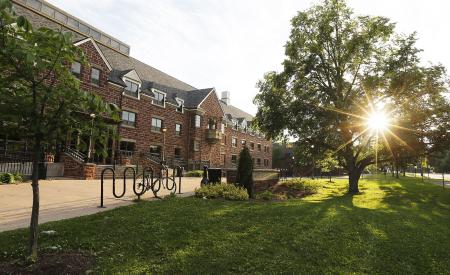Study uses spatial analysis to better understand highway vehicle collisions with elk
With much of Canada’s extensive road network extending through prime wildlife habitat, wildlife-vehicle collisions are a nation-wide problem. Many different mitigation strategies — from fencing to under and overpasses — have been used to try to limit collisions and lower the danger they pose to motorists and animals.
But a recent study in collaboration with 91·đŇŻ researchers found that integrated monitoring and use of adaptive management can be essential for limiting collisions over the long term.
Dr. David Lieske, associate professor in the Department of Geography and Environment at 91·đŇŻ, and Connor Nickel, a 2020 environmental science graduate, collaborated with former 91·đŇŻ faculty member Dr. Jesse Popp, now an assistant professor and Chair in Indigenous Environmental Science at University of Guelph, and Dr. Josef Hamr, a biologist at Laurentian University, to study the impact of highway construction on a re-introduced elk herd in Central Ontario.
Hamr has directed studies of the herd, located near Sudbury, ON, since 1998. The animals’ range is crossed by two highways and a railway line. From 2008–12 the Ontario government twinned Highway 69, which runs between Parry Sound and Sudbury, in the vicinity of the herd’s range. Despite the presence of over and under passes and wildlife fencing, the study found that elk-vehicle collisions more than doubled after construction was complete.
“The issue is that where they built the infrastructure was not where the elk were,” Lieske says, noting that the wildlife fencing was not centred on the herd’s main territory.
The problem was worsened by the unexpected movement of the herd.
“One of our big findings was that there was this unanticipated shift in the distribution of the herd — it shifted north about a kilometre and a half,” Lieske explains. “This was contrary to what we expected — we thought they would go west, away from the highway. What it meant is they were getting past the fencing and onto the highway.”
Although the findings are specific to that area and that herd, Lieske says the study has important lessons for current and future mitigation infrastructure.
“First you need to integrate the best available wildlife science when planning,” he says. “And then you need to be prepared to modify fencing. The idea of build it once and leave it alone — this shows that is not a good approach.”
Lieske says continued monitoring is key.
“Any highway mitigation you do is great, and even in this case, although it didn’t help that herd, it will help other animals. But that is step one. Step two is looking at how to make it maximally effective, and you need to recognize that your initial solution may not be the best one,” he says. “It may take a while to get it right — it’s not a once-all fix.”
The study originated with unanswered questions from Popp’s doctoral work. She in turn collaborated with Lieske to mentor Nickel, whose undergraduate honours thesis work revealed the unanticipated geographic shift in the herd.
“His work had shown that trend, so we went back through it and used some different techniques to look at it in more detail,” Lieske says. “Some really interesting honours thesis work led to this analysis.”
Nickel says he became interested in the project because, as he drove between his home in Nova Scotia and 91·đŇŻ, he became very concerned about wildlife mortality on the highways. He reached out to Lieske to ask about the possibility of doing a research project to map wildlife deaths in the area and Lieske told him about the elk project.
“So that became my thesis. It was related to wildlife conservation and road ecology and offered me an opportunity to learn about why and how animals use our transportation infrastructure, and how we can improve safety and wildlife outcomes,” he says. “Writing a thesis, and completing this project was a huge addition to my undergraduate degree and certainly added a lot of value in terms of academic experience. I was really proud of that work.”
The full research article is available online in .
Photo credit: Ivan Filion



